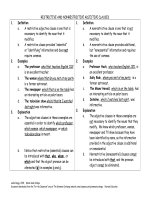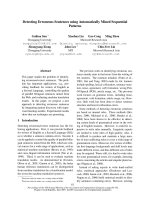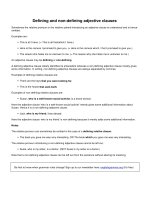Joining two sentences using adjective clauses
Bạn đang xem bản rút gọn của tài liệu. Xem và tải ngay bản đầy đủ của tài liệu tại đây (10.19 KB, 1 trang )
Joining two sentences using adjective clauses
Adjectives
are words used to describe nouns. Examples are:
nice, kind, beautiful, wise
and
hard
. An
adjective
clause
serves the same purpose as an
adjective.
Adjective clauses can be used to form
complex sentences.
As you have already learned, a complex sentence
contains one main clause and one or more dependent or
subordinate clauses.
Study the example sentences given below.
The slave had to fight with a huge lion. The lion was kept in a cage.
Here the second sentence says something about
the lion
mentioned in the first sentence. That means the second
sentence can be converted into an adjective clause describing the noun
lion
.
Adjective clauses are usually introduced by relative pronouns like
who, which
and
that
.
Who
is used to refer to
people.
Which
is used to refer to things.
That
can be used to refer to both people and things.
The slave had to fight with a huge lion
which was kept in a cage
.
OR
The slave had to fight with a huge
lion
that was kept in a cage.
Now let’s analyze the role of the relative pronoun
which
. As you can see, it is the subject of the verb
was.
It also
connects the two clauses.
He has two sons. They have wasted lots of money in idle pursuits.
Here the second sentence says something about the
two sons
mentioned in the first sentence. We can join these
two sentences by using the relative pronoun
who.
He has two sons
who
have wasted lots of money in idle pursuits.
Notes
The verb form used after a relative pronoun should agree with its antecedent in number and person. In the
sentence given above, the verb
have
agrees with the plural noun
two sons
.
Be first to know when grammar rules change! Sign up to our newsletter here: englishgrammar.org (It's free)
Powered by TCPDF (www.tcpdf.org)









